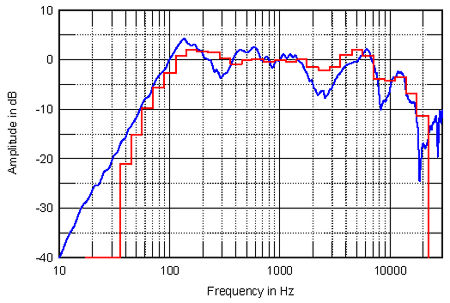

Bohlender-Graebener Radia 520i loudspeaker
Larry Greenhill, December, 2004
![]()
Loudspeaker cabinet design has been strongly influenced by home theater. Large floorstanding cabinets, required for reproduction of bass frequencies, are being replaced by tall, graceful towers with small footprints. While these slim speakers fit more easily into home décor and living spaces, to fill out their bass response they depend on being used with the subwoofers that are standard in multichannel systems.
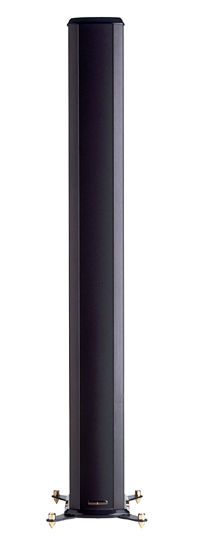 Igor Levitsky, speaker designer for Bohlender-Graebener Corp. (aka BG Corp.), has taken advantage of the slim tower motif in the design of the Radia 520i speaker, which has a 50" midrange-tweeter ribbon driver. This narrow driver offers wider horizontal dispersion than a panel speaker, while suppressing strong early reflections from the floor and ceiling by acting as a line source. A line-source speaker radiates a cylindrical wavefront, which suffers milder propagation losses than does a conventional cone driver. Levitsky mounted the 520i's ribbon driver in a tall, open aluminum frame to minimize cabinet resonance effects.
Igor Levitsky, speaker designer for Bohlender-Graebener Corp. (aka BG Corp.), has taken advantage of the slim tower motif in the design of the Radia 520i speaker, which has a 50" midrange-tweeter ribbon driver. This narrow driver offers wider horizontal dispersion than a panel speaker, while suppressing strong early reflections from the floor and ceiling by acting as a line source. A line-source speaker radiates a cylindrical wavefront, which suffers milder propagation losses than does a conventional cone driver. Levitsky mounted the 520i's ribbon driver in a tall, open aluminum frame to minimize cabinet resonance effects.
The 520i's ribbon covers the spectrum above 350Hz and fires through a 30mm-wide slot in an aluminum frame. The ribbon itself consists of a diaphragm of polymer film strung with aluminum conductors, which carry the audio signal, suspended between push-pull magnet arrays. Levitsky complements the ribbon with two 6.5"-cone woofers mounted in the 520i's 7.75" by 13.75" lower enclosure, made from MDF. These provide bass down to 70Hz. The crossover uses modified fourth-order Linkwitz-Riley filters, with an in-phase driver connection.
Some assembly is required before the Radias can be used. The tall, thin towers must be anchored to their flat brass bases with ¼" hex-head screws. Four legs extend out from the base, each tipped with a sharp spike. Top caps are then mounted on each speaker column. (The caps are packed separately so that the 520i box keeps within UPS's maximum package length.) Although not described in the accompanying information sheets, the metal brackets at the back of each plastic cap must be slid under two mounting screws at the top of the speaker column. The front and back grilles can be removed by pulling them up and lifting them out of their black anodized rails—sort of like unzipping a zipper.
Setup & fine-tuning
I set up the Bohlender-Graebener Radia 520i's in the exact spots usually occupied by my reference Quad ESL-989s: 8' apart, 5' from the back wall, and 3' 9" from the side walls. Moving the BGs into position, I was struck by the towers' height (over 70"), narrowness (under 8"), and relative lightness (59 lbs). I did my listening in my lightly damped, rectangular listening room, which is 26' long, 13' wide, and 12' high. Behind my listening chair, the other end of the room opens into a 25' by 15' kitchen. All listening was done with the BGs' grilles in place. For purposes of stability, I left the spikes in the floor stands.
First, I had to decide: Did I need a subwoofer for this review? Without a sub, the BG Radia 520i generated a wide soundstage, with a smooth upper midrange and highs and fast, accurate sound. On first listen, I was surprised and pleased to find that the 520i also had a fast, true upper-bass response. For soloists and for some percussion, I didn't miss the bass extension. But the lack of the deep bass on recordings that feature bass drum and pipe-organ pedal tones made such music less dramatic and involving. In addition, the 520i's two woofers grew mildly distorted when driven extremely hard with bass drum passages or rock music. Deep, powerful bass drum notes, in particular, seemed muffled and distant, and greatly changed in tonality. I decided to listen with and without a subwoofer.
True, I'd used the BG Radia 520i in the final listening sessions for my review of Revel's Sub 30 subwoofer (Stereophile, November 2004). The Sub 30 had been placed in the right rear corner, behind the plane of the Radias. A pair of stereo interconnects ran from the Mark Levinson ML-7a preamplifier to the line-level right and left inputs on the Sub 30's rear panel. The Sub 30's high-pass filter was set to 80Hz and 12dB/octave, its low-pass filter to 80Hz and 48dB/octave, its Contour switch to Music. Interconnects were run from the Sub 30's right and left output jacks to a pair of Mark Levinson ML-2 power amplifiers, which drove the BGs.
When I first set up the Radias with the Revel sub, the phase and channel-identification checks on Stereophile's first Test CD (Stereophile STPH002-2) revealed that the BGs' phase was inverted. Eric Graul, production manager at BG Corp., helped me track down the problem: the Revel Sub 30's electronics inverted phase. When driven directly from the preamplifier, the 520is were in phase. Whenever I added the Revel to the system, I set its Phase control to 180 degrees.
I then used the built-in signal generator, microphone, and virtual spectrum analyzer of a Velodyne DD-18 subwoofer to evaluate the BG 520i's in-room frequency response at my listening position with and without the Revel subwoofer. (Velodyne's technology is not part of the BG 520i's or Revel Sub 30's standard installation packages; see Stereophile, June 2004, p.133.) I set up the Velodyne's calibration microphone on the back of my listening chair at my ear level, 37" from the floor, and set the DD-18's volume control to "0" so that it would put out no audio signal. I then keyed the Velodyne's remote control to display its System Response screen on my TV monitor. This automatically initiates a repeated sweep tone from the DD-18's signal generator, which is then fed into a tape input on my preamp. When I drove the BG 520i without the subwoofer (fig.A), its frequency response showed peaks at 180Hz and 125Hz, falling gradually below that point, to -3dB at 90Hz and -10dB at 60Hz. Adding the Revel Sub 30 extended the response down to 20Hz, ±6dB (fig.B).
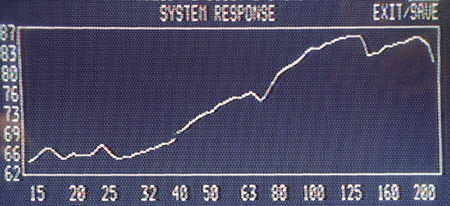
Fig.A BG Radia 520i, in-room response, 15-200Hz (4dB/vertical div.).
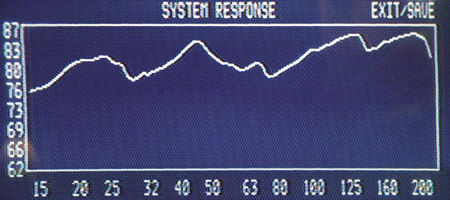
Fig.B BG Radia 520i with Revel Ultima Sub 30, in-room response, 15-200Hz (4dB/vertical div.).
Using pink noise from Stereophile's Test CD 2 (Stereophile STPH004-2) to drive the Radias without the subwoofer, the tonality of the resulting sound varied smoothly and gradually as I moved back and forth and from side to side in my listening chair. I found the Radias' sweet spot in my room to be about 6" wide and 12" deep. To stay within that small spot, I had to sit up and forward in the listening chair. I propped myself in position with two pillows—just moving the chair forward didn't position me properly. Outside this zone, the pink noise dulled slightly. It also dulled when I stood up, but did not vary more when I moved around the room. However, in its narrow sweet spot, the 520i's highs in the pink noise seemed to be fine, or at least equivalent to those I hear with the Quad ESL-989s.
Sound
The BG Radias' strengths were in imaging, speed, extended dynamic range, and translucent mids and highs. Their soundstage was wide and deep, with surprising spatial resolution of different instruments or voices in a chorus. Jerome Harris' Taylor acoustic bass guitar and the kick drum in "The Mooche," from his Rendezvous CD (Stereophile STPH013-2), were placed directly in the center, Art Baron's trombone right of center, and Marty Ehrlich's alto sax far right. The 520i captured the shimmering bronze of Billy Drummond's Zildjian ride cymbal at the song's beginning, the plunger-muted trombone's brassy blattiness, and the crackle of the air in the mouthpiece of the sax. I was easily able to hear the call and response between trombone and sax.
The Radias accurately reproduced the spatial ambience of Robert Silverman's performance (via a large Bösendorfer reproducing piano) of the second movement of Beethoven's Piano Sonata 24, Op.78 (from his 10-CD set of the complete sonatas, OrpheumMasters KSP 830, engineered by John Atkinson), and the reediness and acoustic venue surrounding Antony Michaelson's clarinet in the Larghetto of Mozart's Clarinet Quintet in A, K.581, from Mosaic (CD, Stereophile STPH015-2). Listening to the excerpt from Elgar's The Dream of Gerontius on Test CD 2 (Stereophile STPH004-2), I was stunned by the width and depth of the soundstage: tenor far left, brass section far right, and the double choir set well back.
Well-recorded vocalists and instruments were what most benefited from the 520i's clarity and dynamics; they were reproduced with their timbres balanced and natural, free of speaker-introduced tonalities. Bud Shanks' virtuoso alto-sax and flute playing on the title track of the L.A. Four's Going Home (CD, East Wind 32JD-10043) had highs that were extended, open, and smooth. During "Silk Road" and "Running Water," from I Ching's Of the Marsh and the Moon (CD, Chesky WO144), I greatly enjoyed the timbres, sonorities, and resonances of Sisi Chen's Chinese dulcimer and Tao Chen's bamboo flute.
Dynamics were reproduced with incredible speed and an unusually wide range. The otherwise transparent and speedy Mark Levinson ML-2 monoblocks (50W RMS into 4 ohms) began to clip, so I switched to the more powerful Mark Levinson No.334 stereo amp (250Wpc RMS into 4 ohms) to get a better sense of the 520i's dynamic capabilities. Eva Cassidy, singing "Bridge Over Troubled Water" on Live at Blues Alley (CD, Blixstreet G2-10046), never sounded so good. The BG 520i conveyed the stunning dynamic range of her voice without ever overloading, honking, or running out of steam. I was also transfixed by the shimmer, sheen, timbre, and reediness of the reverberating chimes and the bassoon that open Owen Reed's La Fiesta Mexicana, on Fiesta (CD, Reference RR-38CD). However, the Revel Sub 30 was needed to hear the drama and power of the bass drum that opens this piece.
The subwoofer also enabled the Radias to span the dynamic range between drummer Mark Walker's tiny cymbal taps and the room-shaking kick-drum beats on "Nardis," from Patricia Barber's Café Blue (CD, Premonition/Blue Note 21810 2). Similarly, the Radias resolved the tangled but powerful syncopations underlying Brady Blade's explosive drum solo on "The Maker," from Emmylou Harris' Spyboy (CD, Eminent EM-25001-2). This live performance was resolved with stunning detail by the 520i: Harris' burned-out voice, the crowd noise and catcalls, Buddy Miller's lead electric 12-string and mando guitar, Blade's tight work on snare, bass pedals, and tom-toms. The Sub 30 also allowed me to enjoy deep organ-pedal passages with the Radias, particularly those in "Lord, Make Me an Instrument of Thy Peace" and "A Gaelic Blessing," from John Rutter's Requiem (CD, Reference RR-57CD).
The culmination of my listening experiences with the BG 520i was its dead-on portrayal of the complex orchestral timbres, instrumental placement, syncopated rhythms, driving pace, and wide dynamic range of Stravinsky's The Rite of Spring, performed by Eiji Oue and the Minnesota Symphony (CD, Reference RR-70). The 520i fully captured the eerie bassoon solo, played in an unusually high register, that opens the work. I heard and sensed the ballet's driving rhythms, magnified by the offbeat accents and the complex asymmetry of soft trumpets answered by cello pulses in the "Convocation of the Ancestors," where the roll of timpani is reinforced by the huge beat of a bass drum. The frenzy mounted further in the "Sacrificial Dance," where the speaker's superfast recovery allowed it to reproduce the sound of the musicians turning pages between timpani strokes! I found myself closing my eyes and tumbling into the music, so overpowering and involving was the experience.
Conclusions
The Bohlender-Graebener Corp. has achieved its goal of designing and manufacturing a tall, slim line-source loudspeaker with a small footprint that can compete with more expensive audiophile designs. The Radia 520i is faster, more dynamic, and better at imaging and involving the listener in the drama of music than it has a right to be at its price of $3998.
But doesn't it need a subwoofer to realize its full potential? While that's true, you might not miss a subwoofer if your musical tastes run more to singers than to pipe organs—I thought Eva Cassidy and Emmylou Harris sounded better when the Revel Sub 30 subwoofer wasn't playing. Many potential owners could start with the Radia 520is alone, then add a subwoofer if needed.
I was surprised to discover that the 520i put out enough bass for a range of different types of music. However, it couldn't repeal the laws of physics. When the music's bass demands increased, the 520i's woofers could strain and distort. Most often, the Radias provided clean, nonfatiguing sound, superb soundstaging that placed the instruments and voices with rock-solid stability, a wide dynamic range, and overall transparency. Add to all that its high build quality, moderate price, and ability to capture small musical details and instrumental timbres, and the Radia 520i earned my respect.
At $4000/pair, this loudspeaker is the best high-end value I've encountered in a long time, and its quality grew even more over the time I spent with it. Bohlender-Graebener Corp.'s Radia 520i gets my strongest recommendation.
Sidebar 1: Specifications
Description: Two-way, floorstanding, sealed-box loudspeaker with line-source ribbon upper-frequency driver. Drive-units: 50" by 1.1" planar-magnetic coaxial midrange and HF ribbon; two 6.5" cone woofers. Crossover frequency: 350Hz. Crossover slopes: fourth-order, Linkwitz-Riley. Frequency response: 70Hz-20kHz, ±6dB. Sensitivity: 88dB/2.83V/m. Nominal impedance: 4 ohms. Recommended amplification: 50-250W continuous, 300W peak.
Dimensions: 70.25" (1800mm) H by 7.75" (200mm) W by 2.75" (70mm) D. Base: 13.25" (340mm) W by 17.25" (442mm) D. Weight: 59 lbs (26.8kg).
Finishes: Black anodized aluminum tower, black or mahogany base.
Serial numbers of units reviewed: 02222, 02223.
Price: $3998/pair. Approximate number of dealers: 125.
Manufacturer: Bohlender-Graebener Corp., 1780 Forrest Way, Carson City, NV 89706. Tel: (888) 875-2627, (775) 884-1800. Fax: (775) 884-1276. Web: www.bgcorp.com.
Sidebar 2: Associated Equipment
Analog source: Linn Sondek-Lingo turntable, Linn Ittok tonearm, Spectral moving-coil cartridge.
Digital sources: Krell KRC-28 CD player, Sony SCD-C555ES multichannel SACD/CD player.
FM tuners: Day-Sequerra Classic, McIntosh MR-78, Sony ST-5000.
Preamplification: Mark Levinson ML-7 preamplifier with L3A MC phono cards, Margulis phono section, Duntech MX-10 head amplifier, Krell KCT preamplifier.
Power amplifiers: Mark Levinson ML-2 monoblocks and No.334 stereo amp; Krell FPB 600c.
Loudspeakers: Quad ESL-989, Revel Ultima Sub 30 subwoofer.
Cables: Interconnect: Red Rose Silver Ones, Krell CAST, Levinson Silver single-ended, Bryston balanced. Speaker: Mark Levinson HFC 10, Pure Silver Cable (PSC) R50 biwire double ribbon, Ultralink Excelsior 6N OFHC, Coincident Speaker Technology CST 1.—Larry Greenhill
Sidebar 3: Measurements
Ribbon speakers have historically offered low voltage sensitivity, but my estimate of the Bohlender-Graebener Radia 520i's sensitivity came in at 87.5dB(B)/2.83V/m, which is about average. However, its impedance lies at 4 ohms or below for much of the audioband, reaching a minimum value of 2.9 ohms at 165Hz. In addition, the combination of 4.2 ohms and -50 degrees capacitive phase angle at 120Hz, a frequency where music tends to have high energy levels, will stress lesser amplifiers. The impedance graph (fig.1) is free from the small wrinkles that would imply the existence of mid-frequency cabinet resonances. I couldn't get my accelerometer to stick to the rough black finish of the Radia 520i's small woofer enclosure, but it seemed inert to the knuckle-rap test. The small panel dimensions also mean that there is very little surface area to couple panel vibrations to the air.
The single bass peak at 80Hz in the impedance magnitude trace (fig.1) suggests that this is the tuning frequency of the woofers' sealed enclosure. This peak usually coincides with a speaker's -6dB point, which would suggest that the BG 520i offers only limited low-frequency extension. This is confirmed by the individual responses of the woofers and ribbon unit, shown in fig.2. (Both curves are a combination of the farfield response above 450Hz spliced to the nearfield response below that frequency.) The nearfield measurement technique boosts the apparent level of the upper bass, but even so, the 520i's bass rolls off below 120Hz or so. In-room, the fact that the woofers are placed close to the floor will give some useful reinforcement in the mid- and upper bass.
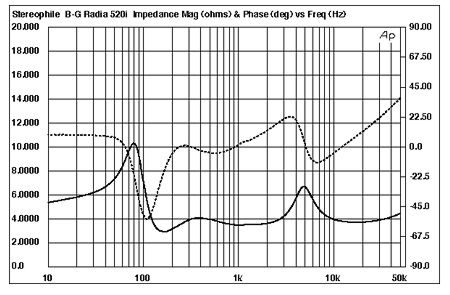
Fig.1 BG Radia 520i, electrical impedance (solid) and phase (dashed). (2 ohms/vertical div.)
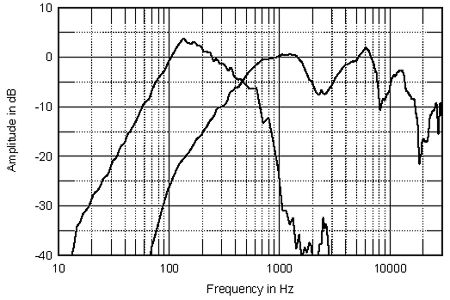
Fig.2 BG Radia 520i, acoustic crossover on center-of-ribbon axis at 50", corrected for microphone response, with the nearfield responses of the woofer and ribbon plotted below 450Hz.
The ribbon unit appears to take over above 400Hz, but its output is marred by roughly equal dips and peaks up to about 15kHz, above which it rolls off steeply. The microphone was placed 50" away from the speaker on an axis level with the midpoint of the 50" drive-unit, and this may well not have been far enough away to properly characterize the behavior of a drive-unit as long as the Radia's ribbon. Even so, the unevenness of the measured response was consistent, and can also be seen in the Radia's response averaged across a 30 degrees horizontal window on the same axis (fig.3). This graph also shows a slight lack of lower-midrange integration between the two drive-units.
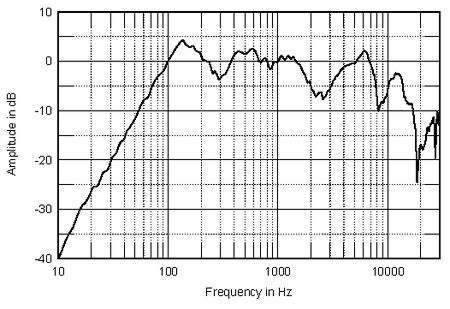
Fig.3 BG Radia 520i, anechoic response on the center-of-ribbon axis at 50", averaged across 30 degrees horizontal window and corrected for microphone response, with the complex sum of the nearfield woofer and ribbon responses, taking into account acoustic phase and distance from the nominal farfield point, plotted below 300Hz.
The ribbon driver has fairly wide horizontal dispersion (fig.4), but this is somewhat uneven with frequency, there being a flare in the treble region where the on-axis response had a lack of energy. In rooms of small to medium size this might well result in a more smooth, even treble balance at the listening chair. But note the sharp drop in output as the microphone approaches 90 degrees off-axis, due to the ribbon's dipole behavior. In the vertical plane (fig.5), the long ribbon acts as a line source, meaning that the balance changes very little with quite large changes in listening axis.
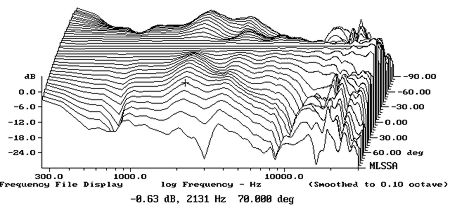
Fig.4 BG Radia 520i, lateral response family at 50", normalized to response on center-of-ribbon axis, from back to front: differences in response 90 degrees-5 degrees off-axis, reference response, differences in response 5 degrees-90 degrees off-axis.
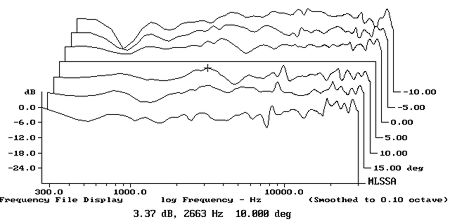
Fig.5 BG Radia 520i, vertical response family at 50", normalized to response on center-of-ribbon axis, from back to front: differences in response 15 degrees-5 degrees above axis, reference response, differences in response 5 degrees-15 degrees below axis.
Turning to the time domain, the Radia 520i's impulse response (fig.6) has a fairly good, time-coherent shape, its tail overlaid with some high-frequency ringing and what might be a close-spaced second arrival. This is also apparent in the step response, where what would have been a good right-triangle shape is disturbed by the second arrival. Both drive-units are connected with the same positive polarity; the positive-going hump in fig.7 results from the tail of the ribbon's step coinciding with the slow rise of the woofers' step.
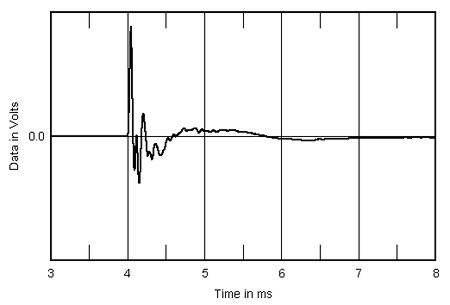
Fig.6 BG Radia 520i, impulse response on center-of-ribbon axis at 50" (5ms time window, 30kHz bandwidth).
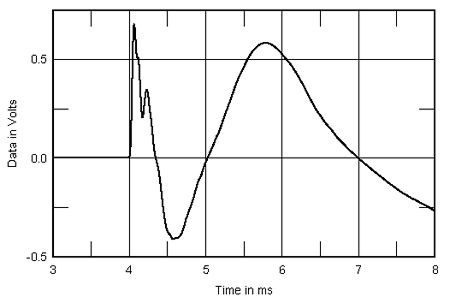
Fig.7 BG Radia 520i, step response on center-of-ribbon axis at 50" (5ms time window, 30kHz bandwidth).
Finally, the Radia 520i's farfield cumulative spectral-decay, or waterfall, plot (fig.8) is not as clean as I would like to have seen, with some delayed energy apparent in the low treble, though this doesn't appear to be due to resonances per se.
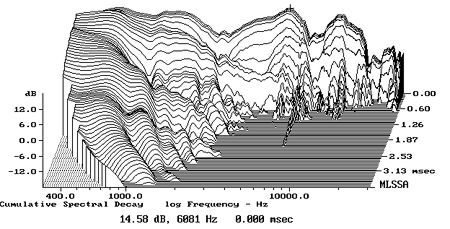
Fig.8 BG Radia 520i, cumulative spectral-decay plot at 50" (0.15ms risetime).
Measuring physically large speakers is always to some extent an exercise in frustration, because the inherent assumption made when a speaker is measured—that the microphone is in the farfield—is no longer correct at all frequencies. It is possible, therefore, that some of the aberrations seen in the Radia 520i's measurements are exaggerated. In which case, the best way to judge the speaker is to listen to it. I note that Larry Greenhill ended up being very impressed by the sound of the Bohlender-Graebener. I will set up the Radia 520i speakers in my own room and report on their sound in a Follow-Up to appear in the January issue.—John Atkinson
John Atkinson wrote about the Radia 520i in January 2005 (Vol.28 No.1):
When I measured the Radia 520i loudspeaker for Larry Greenhill's review in the December issue (p.115), I was bothered by the apparent unevenness of the 50" ribbon unit's frequency response. This unit covers the region above 400Hz, and its output was marred by roughly equal dips and peaks up to about 15kHz, above which it rolled off steeply. The microphone was placed 50" away from the speaker on an axis level with the midpoint of the ribbon for the quasi-anechoic measurement, and, as I wrote, this may well not have been far enough away to properly characterize the drive-unit's behavior. (The inherent assumption when measuring a loudspeaker's response is that the microphone is much farther away than the longest dimension of the speaker. With a 6'-tall speaker such as the Radia, that condition cannot realistically be met.)
I therefore set the review samples up in my own listening room, both for a weekend of auditioning and to carry out a spatially averaged response of the speakers' output at the listening position. (I average 120 individual 1/3-octave response measurements for each speaker driven on its own in a grid 18" high and 36" wide centered on the position of my ears.)
The results are shown in fig.9. The blue trace is the quasi-anechoic farfield response published in the December review, taken with a calibrated DPA omnidirectional microphone and DRA Labs' MLSSA system. The peaks and dips mentioned earlier are readily apparent, though it should be noted that the energy excess at 125Hz is an artifact of the nearfield measurement technique used to generate the trace below 300Hz.
The red trace is the spatially averaged response in my room, which takes into consideration the reverberant field, which in turn depends on the speaker's radiation pattern. (I used an AudioControl SA3050A spectrum analyzer, with its own calibrated microphone, for this measurement.) As Dr. Greenhill found, the speaker's mid- and low-bass output is prematurely rolled off, though in a well-controlled manner. The 520i is thus a natural match for a subwoofer. The unevenness in the anechoic on-axis curve can also be seen to smooth out, and the in-room response actually meets commendably tight ±2dB limits from 125Hz to 7kHz. Above that frequency, the Radia 520i's output falls off rapidly, pretty much mapping the anechoic curve.
Listening to the Radias (footnote 1), I was impressed both by the superbly defined, stable stereo imaging and by the smoothness of the sound. Bass was missing in action, but this was offset by the fact that there was no sense that the audioband was being covered by disparate drive-units. The integration between the twin 6.5" cone woofers and the ribbon was very well implemented.
However, while the suppressed top octave was not an issue for much of the time with both classical recordings and the usual overcooked modern rock discs, the lack of "air" in the Radia 520i's balance did occasionally intrude on recordings with naturally balanced high frequencies, such as the chamber-music recordings on my Editor's Choice CD (Stereophile STPH016-2). More important, I was sometimes bothered by a narrow band of brightness. This was audible, for example, as an added edge to the sounds of the solo voices on last September's "Recording of the Month," the Nikolaus Harnoncourt/Concentus Musicus Wien performance of Mozart's Requiem (SACD, Deutsche Harmonia Mundi 82876 58705 2). This balance correlates with the presence-region dip and the slight excess of energy in the mid-treble in the in-room response, my ear latching on to the latter as brightness rather than on to the former as a lack of presence. The opposite could also happen: Eric Clapton's Me and Mr. Johnson (CD, Reprise 48423-2) sounded too polite (though it must be said that Mr. C. does sound asleep at the wheel for much of this set).
Larry Greenhill summed up the Bohlender-Graebener Radia 520i as providing "clean, nonfatiguing sound, superb soundstaging that placed the instruments and voices with rock-solid stability, a wide dynamic range, and overall transparency." I'd say he basically nailed it, though I would want more top-octave energy.—John Atkinson
Footnote 1: My system comprised Mark Levinson No.33H monoblocks driven directly by a dCS Elgar Plus D/A converter fed by a dCS Verdi/Purcell SACD/CD front-end clocked by a dCS Verona and connected with a 1m length of DH Labs AES/EBU cable, as well as with dCS's FireWire links. Speaker cables were 1m lengths of AudioQuest Kilimanjaro; interconnects were 5m lengths of balanced Madrigal CZ-Gel.—John Atkinson
